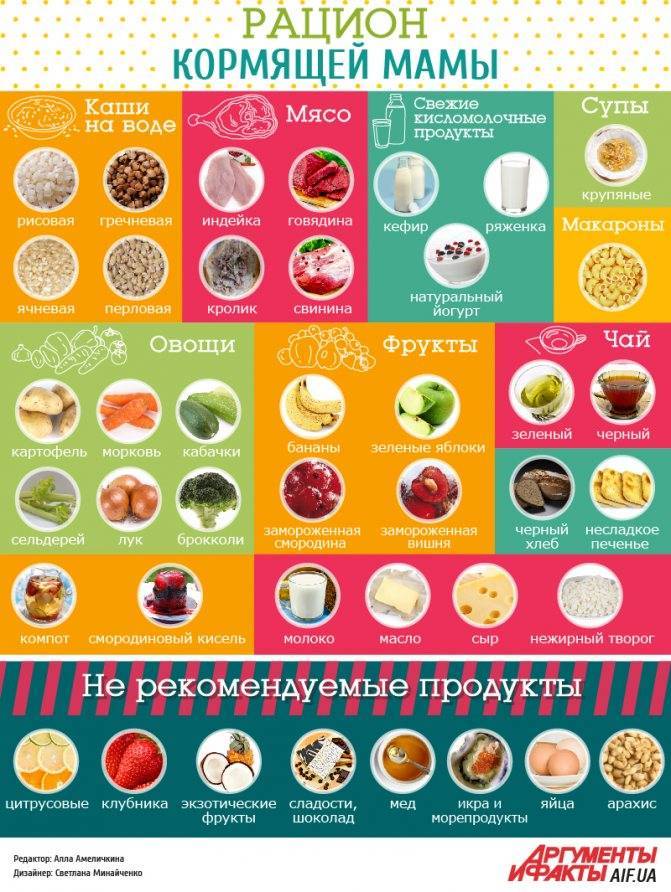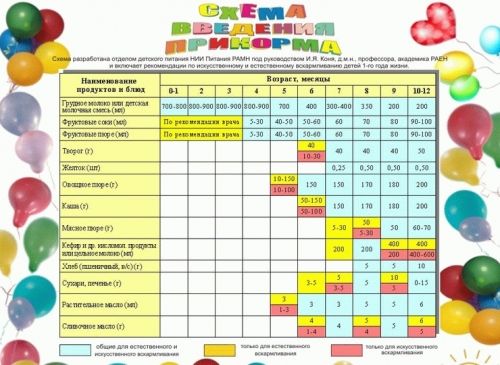Optimal time for complementary feeding according to Komarovsky
Introducing complementary foods is an important period that requires the right approach. Young mothers do not know when it is best to introduce complementary foods, and are interested in Komarovsky’s opinion. The famous pediatrician claims that the first complementary feeding of a baby, whether on natural or artificial feeding, should begin at 6 months.
Some parents are mistaken in believing that if their baby is fed formula, then it is necessary to feed him earlier.
But Dr. Komarovsky, speaking about the development of newborns by month, focuses on the underdevelopment of the digestive organs in all babies up to six months.
Modern formulas are developed taking into account the characteristics of infants; infants receive all the required nutrients. Therefore, parents should not rush to introduce complementary foods.
The first adult food should arrive in a timely manner, because:
- children's immune response is not fully formed;
- the digestive system is not ready for new foods, stool upset may occur;
- early complementary feeding leads to allergic reactions;
- a newborn does not need an additional source of vitamins.
Early complementary feeding: risks
Introducing complementary foods early is just as dangerous as introducing them later. In the process of chewing food, teething pain is relieved and natural eating habits are formed.
In addition, playing with any food product contributes to the psycho-emotional development of the baby by improving fine motor skills. When food is added late, the described processes slow down.
Early feeding can be justified only in cases where the baby is underweight, has hypovitaminosis or iron deficiency anemia. In such situations, the mother is recommended to give the child yolk, apple juice, and porridge.
But you should not feed your baby baby food, since the age indicated on the packages is usually not true.
Feed your baby breast milk or formula for up to six months, and then feel free to enrich the baby’s diet in accordance with his age.
How to understand that your baby is ready for new foods
Evgeny Komarovsky identifies several signs by which a mother can understand that her baby is ready for the first feeding. These include the following children's abilities:
- show interest in new nutritional elements;
- sit independently;
- take food from a spoon;
- turn away from unpleasant foods.
If the baby’s body weight has doubled, this also indicates his readiness for complementary feeding.
Buying or preparing yourself: which is better for the child?
Neither Evgeniy Olegovich nor the WHO can unequivocally answer the questions of many mothers about the benefits of store-bought or self-prepared food products. The main quality that products intended for children should have is their high quality.
Modern baby food production has all the technologies capable of producing high-quality and safe products for children. Parents' approach to "store-bought" products saves, first of all, their time, which can be spent on paying attention to the child and his needs.
Self-cooking, although it takes time, guarantees 100% quality and often financial savings. Moreover, when preparing it yourself, you can regulate all stages of product readiness.
Video: how to prepare complementary foods
But to achieve a good result, parents must control the high quality of the raw materials. The decision to buy store-bought products or prepare them yourself depends on the beliefs and capabilities of the parents.
General principles of complementary feeding
Evgeniy Olegovich Komarovsky recommends that parents use the following complementary feeding rules:
- Introduce a new nutritional element only when the baby is healthy. Malaise can provoke an unhealthy reaction in the body, and you will not be able to track your baby’s reaction to new food.
- Give new food before the main meal. Then supplement your child with milk or formula.
- Enter foods one at a time. If there are no negative reactions, give your baby something new after a few days.
- Do not force your child to eat if he spits out food and turns away from the spoon. Try again after a few days, maybe your baby will try the new taste and like it.
- Replace one feeding with new food gradually. Initially, give your child a spoonful of vegetable puree and supplement with milk. The next day, give 2-3 spoons of puree, and continue to increase the amount of complementary foods until it completely replaces one meal.
- It is recommended to introduce a new product in the morning. If your baby has a tummy ache or an allergic reaction, you can correct the situation and avoid a sleepless night.
Complementary foods according to Komarovsky contain salt. The pediatrician claims that the child’s body needs it, just like an adult.
The only difference is in the quantity: the child needs very little salt so that the food does not seem bland to him. The doctor is categorical about sugar; he claims that there is no need to specifically sugaren dishes.
Diet of a nursing mother
A mother’s nutritious diet is the main source for the child to receive the substances necessary for development.
What to eat and drink:
- Meat and fish (low-fat);
- Dairy and fermented milk products (milk, fermented baked milk, kefir, etc.);
- Vegetables and fruits: cherries, watermelon, grapes, apples, pears, apricots. We also read: fruits during breastfeeding and vegetables during breastfeeding;
- Dried fruits (dried apricots, raisins) and compote made from them;
- Greenery;
- Green tea;
- Not dried or salted fish;
- Stewed, baked and boiled dishes.
You should not eat or drink:
- Fatty dishes (including fatty broth);
- Coffee;
- Spicy, salty, sour dishes;
- Smoked and fried foods;
- All types of conservation;
- Cocoa and cocoa-containing products (sweets and chocolate);
- Sweets containing buttercream;
- Peas;
- Citrus fruits (oranges, tangerines, lemons);
- Baking with yeast;
- The berries are red;
- Mushrooms.
The daily diet should contain at least 0.5 kg of fresh fruit. If the mother is slim enough and can afford it, Komarovsky recommends eating a plate of semolina at night. All products that a mother accustoms her baby to during pregnancy and breastfeeding will subsequently be accepted by the child with pleasure, because these are familiar foods.
Dietary recommendations

A well-known pediatrician advises to be very careful about the presence of exotic fruits or imported products in your diet. Such food is obviously unknown to our digestive system and its absorption by the body may be incomplete. The occurrence of stress on the liver or pancreas negatively affects breast milk.
The doctor gives some more advice:
- Avoid overeating. It would be healthier to undereat a little;
- If you have an obsessive desire to eat something forbidden, you can “discourage the desire” with a tiny amount of this product;
- Doubts about the product should lead to complete rejection of it;
- You should not eat at night;
- If circumstances forced you to drink alcohol, then a little red wine is acceptable;
- Taking vitamin complexes should be regular.
What foods to introduce and when
The feeding table for children, which is recommended by the famous pediatrician for breastfeeding, is as follows:
| Food | Acceptable age |
| Children's kefir | 6 months |
| Children's cottage cheese | 6.5 months |
| Baked apple | 7 months |
| Egg yolk, porridge, vegetable and fruit puree | 8 months |
| Meat puree | 9 months |
| Fish puree | 10 months |
Whole cow's milk is not recommended for children under one year of age.
Commandment 5

No variety. Well, as an adult you want a variety of foods. After all, we already understand the taste qualities, and we want to constantly try something new and so on. Children under one year old are generally not familiar with the taste of many foods, and what seems disgusting to you because it is unsalted is perceived as normal by them; they do not know anything else. This is the most important point that parents should remember.
Remember, we are made up of what we eat. Why then do we ourselves turn our children into addicts to sweets, soda, and later gastroenterology patients?
Let us remind you that we recently told you how to properly wash your hands using Dr. Komarovsky’s method. By the way, not everyone agreed with the pediatrician.
Scheme for introducing the first products
Komarovsky believes that the best first complementary food is kefir, since it contains bifidobacteria that improve intestinal microflora. Kefir also boosts children's immune response.

This fermented milk product is introduced as follows:
- For the first time, give the baby 2-3 teaspoons of kefir, then feed the baby with formula or breast milk.
- Be sure to monitor the body’s reaction; if there are no negative symptoms, the next day increase the volume by 2 times.
- Continue to increase the volume daily until you reach 160 ml - then you can completely replace one feeding.
Then start introducing cottage cheese into your baby’s diet. The norm for a 6-month-old child is 30 grams, a 9-month-old toddler should eat about 90 grams.
After adapting to fermented milk products, let your baby try a baked apple. The dessert helps improve immunity, development of muscle and bone structures due to the high content of vitamins and microelements.
After the apple, offer your little one oatmeal, buckwheat or rice porridge. Prepare it with a mixture appropriate for the child’s age or purchase a special children’s porridge.
The pediatrician recommends feeding the baby a hearty meal before bed at night, this will increase the duration of the child's sleep.
Rule #10. The period for complete feeding replacement is a week.
By and large, I must tell you that, as a rule, for a complete replacement of feeding - for example, we decided to give the child oatmeal - as a rule, the optimal period for completely replacing the mixture with oatmeal is about a week. It's clear? That is, we know that the child eats this milk formula. Today they gave 20 g, tomorrow 40, the day after tomorrow 80, etc. – a week to replace feeding.
The rules are over. Now these are very interesting things, because again, medical science does not stand still.

Complementary feeding and allergies
For example, in the USA there is a very acute problem associated with, for example, peanuts. They have a very common - you probably know - peanut butter. They have a huge number of children with peanut allergies. And all their lives they told mothers: “Never give peanuts to small children! This increases the likelihood of allergies!”
And suddenly, literally a lot of recent studies prove that, it turns out, if children from 6-8 months are given small quantities of peanuts, this sharply reduces the likelihood of allergies later when they are older.
That is, this is how everything changes. Another question is that if there are people with allergies in the house, if this topic is, in principle, relevant for the family, then it is better not to conduct such experiments.
Why am I saying all this? Very often, right now, your doctor can advise you on something that goes against what is written in many books. But science does not stand still and everything changes.
For example, fish. In many books they write that fish is better after a year: we start complementary feeding with meat, and then fish. And now, if a child receives fish soup or pieces of fish in broth, starting from 8 months, it turns out that there will be nothing wrong with it - please, good health!
And one last piece of advice for you.
Complementary feeding as knowledge of the world
You know, it turns out that almost the most luxurious thing about complementary feeding is the process of eating itself, when the child himself is using his hands and spoon. But in our country, complementary feeding often looks like this: they sit you down, wrap it up, put in a cone, 2 cones, and then a bottle.
Guys, try to do this already at 6 months - complementary feeding at 6 months, when he starts eating this cottage cheese - this, as you understand, has absolutely nothing to do with calories, with food. Yes, this is actually learning about the world, new ways of eating.
Therefore, they sat the little one down, put a plate in front of him, gave him something that looked like a spoon, and let him try to eat. Yes, he will be covered from head to toe in this spoonful of curd. He will still get dirty sooner or later, but, nevertheless, this is very healthy for his development, for his motor skills, for his intellect.
It's very cool when a child learns that he will eat himself. It's better than watching cartoons on TV together
I draw your attention to this. You want to give your child cottage cheese - you sit the child down, give him a plate, sit opposite him with exactly the same plate with cottage cheese, and eat this cottage cheese
He looks at you and repeats.
I really want your children to look at you, and not at cartoons on TV. Explain to dad that he is needed by personal example in the process of complementary feeding much more than all Masha and the bears combined.
Introduction to complementary feeding of vegetables
The next stage will help you accustom your child to vegetables. Before introducing any vegetable (broccoli, carrots), try making vegetable broth and giving it to your baby in a bottle. Add chopped cabbage, onions, potatoes and carrots to the broth.
In the absence of negative manifestations, it is allowed to give the child puree soup, vegetable puree, adding a few drops of vegetable oil to the dishes.
Before adding meat, it is also recommended to initially let the baby taste the cooked meat broth, and only then you can add a little meat to the vegetable puree. Feel free to add boiled chicken yolk (one fifth) to vegetable puree. Children tolerate this product well.
Commandment 2

Don't use your grandmother's experience. No one doubts that our grandmothers and great-grandmothers raised us to be healthy, strong people. Thank them very much for this. But let's think a little. Do you remember what the environment was like when we were raised and educated? Nothing particularly bad was observed; in childhood, we could easily cover the wound with dust to stop the bleeding. And now? It's better not to risk it, to be honest.
In addition to the environment, there is the quality of the products. Nowadays everything is built on money, so in order to preserve many products they have to be constantly treated with something dangerous. In general, this is not an option for a small child’s body.
Why does the doctor recommend store-bought nutrition?
Komarovsky advises mothers to purchase baby food in stores. The pediatrician explains it this way:
- the finished product has the correct consistency suitable for a certain age;
- food undergoes all types of control;
- enriches the children's diet with essential nutritional compounds, prebiotics, vitamins;
- harmonious combination of ingredients.
But the main advantage of store-bought products is the reduction of time costs for women. A young mother can devote her free time from cooking to her husband, herself, or play educational games with her baby.
Home-cooked food also has its benefits. It requires lower financial costs, and the food has a higher taste. When cooking at home, you control the portion yourself and can be sure of the freshness of the dish.
We stick to the rules
When introducing the first complementary foods to infants, you need to know the rules. It is the rules that will help prevent possible problems from arising.
Complementary feeding rules:
- Despite the signs present, do not start complementary feeding until four months.
- The type of main feeding does not affect the nature of complementary feeding.
- The introduction of new products begins when the child is healthy. No runny nose, malaise, teething.
- Consider the circumstances. It is not advisable to introduce a new type of complementary food on the eve of vaccination, travel, etc.
- Adult food is given before the infants' main meal. First complementary foods, then breast milk, formula.
- Don't force the child if he refuses. Try introducing a new taste several times over a short period of time.
- Introduce one product at a time. For example, first porridge, then porridge with an apple.
- A week is given to replace one feeding.
- The food needs to be slightly salted.
The rules are advisory in nature only. Consult your pediatrician about this or that rule. Dr. Komarovsky video, table, scheme for convenient introduction of complementary foods advises where to start. Choose an option to start feeding your baby.
- kefir, cottage cheese;
- milk and cereal porridges;
- vegetable soups, purees.

The complementary feeding scheme for a child at six months suggests that within a week you need to replace one regular meal with complementary foods. For example, at six months we feed the baby kefir for lunch. So for a week. Then gradually add cottage cheese to kefir over the course of a month.
The complementary feeding scheme for a child at seven months suggests that we continue to give kefir and cottage cheese for lunch. For dinner during the week we introduce any milk porridge. After the baby has gotten used to the porridge, we introduce a different taste. For a month we have been trying to give buckwheat, rice, and oatmeal.
The eight-month regimen establishes, two hours after kefir, the gradual introduction of vegetable soup and puree.
At nine months and up to one year, it is necessary to include mashed potatoes and lean meat in lunch. Rub the meat with puree, mixing with milk. We cook soups in fish broth, adding yolk. When a variety of cereals have become familiar, add fruit. The only option is to breastfeed or formula feed once in the morning or before bed.
Remember! When introducing new flavors, do it gradually, in small quantities. One to two teaspoons. Be careful with foods that cause allergies. E. O Komarovsky video recommends the commandments of healthy, proper nutrition for infants.
- Don't follow the example of others.
- The experience of grandmothers is not relevant. Don't follow advice blindly.
- Don't get carried away with quantity.
- Don't force it.
- No sharp variety of tastes.
Dr. Komarovsky's video advice will help you correctly approach the issue of introducing complementary foods during breastfeeding and start taking action. Don't experiment. The health of your beloved child is most important.
What Komarovsky says about supplementary feeding during breastfeeding
According to Komarovsky, mother's milk is the only food that a newborn needs for the first 5 months of life. It is balanced in composition; with proper application and feeding regimen, mother's milk fully satisfies all the needs of the baby. The child is gaining weight well and does not need additional feeding with formula.
If the baby is not gaining weight or lactation is reduced, only in this case should you think about supplementary feeding. Here are the tips that a famous pediatrician gives to a young mother if the child does not gain the required weight at control weigh-ins:
- Do not stop breastfeeding so as not to stop the lactation process. Check that your newborn is latching correctly: breastfeed with a nurse or doctor present to get advice and identify any latching errors.
- Stimulation of the nipples leads to activation of lactation and an increase in milk production, so continue breastfeeding for at least three more days after the control weighing.
- If after three days the amount of milk has not increased, and the child continues to feel unwell, introduce supplementary feeding with artificial formulas.
- If the condition of the newborn improves and stool normalizes, continue breastfeeding until the age of five months.
The most important thing, as Komarovsky notes, is that the mother does not get nervous during this period, this will further reduce lactation. A favorable psychological background and positive attitude of the mother are the key to a successful solution to the problem.











